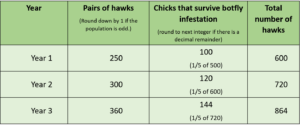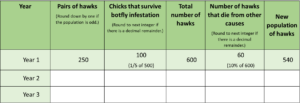Number (fractions): Helping Hawks
The Problem
Jamie created a table (opposite) to show the changing population of Ridgway’s hawks over a 3-year period. It was based on the following data facts:
- There are 250 pairs of Ridgway’s hawks left in the Dominican Republic.
- Each pair of hawks lays 2 eggs per year.
- Only 1/5 of the chicks born each year survive botfly infestation.
Look carefully at table A. What assumptions has Jamie made?
After further research, Jamie discovered an aditional fact:
- Each year, 10% of the entire population of Ridgeway’s hawks die from other causes.
Using this fact, can you complete the revised table (B) for the 3-year period?
How long will it take for the population of Ridgeway’s hawks to exceed 700?

Did you know?
In one study of 20 nesting pairs, biologists documented that reptiles comprised 97% of the Ridgway hawk’s prey items. That’s a lot of snakes and lizards!
Visualising the Problem and Getting Started
Jamie’s table (A)

Revised table (B)

Teacher note: As this is ‘real world’ maths – the numbers aren’t always tidy integers. For the purposes of the table, the children will need to use their knowledge of rounding. Instructions for this are given in the table headings.

 Sign in
Sign in

